Blessed with great hearing and strong night vision, Army draftee Lance Grebner was often assigned night watch duty for his company in the Vietnamese central highlands during his 1968-69 tour. His story of becoming a go-to guy on the starlight scope brought up some Naval and academic memories for me. Then his narrative took a turn way beyond my field of vision—down a path not fit for sensitive readers. On that path I heard some scary things, recited some poetry, put my foot in my mouth, and tried my best to channel it all into half of a portrait.
I work as a figurative painter. For the past few months, sculptor Christopher Wagner and I have been brushing and carving on a series of two-media portraits of combat veterans we’re calling Between Here and There, a project funded by the Regional Arts and Culture Council. Right now, we’re in the middle of creating ten pairs, a sculpture and a painting of each vet created from live models, simultaneously. Setting aside the common image of the homeless, needy veteran or the uniformed vet just off the plane from Iraq, these portraits celebrate each of our subjects as an individual with his or her own tastes and biases. Chris and I ask each model to bring props and clothing to express what they love to do here in Portland. One vet brought her bicycle to the studio. Another posed with his squash racket. Others have played guitar, sent text messages, and even flipped upside-down with a powerful grip on gymnastics rings that we hung from the ceiling—an amazing effort, since we don’t work from photos.
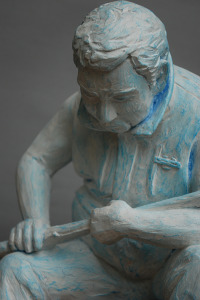
A working proof of Christopher Wagner’s sculpture of Lance Grebner, an Army veteran who
saw heavy combat in Vietnam. Polyurethane coated in acrylic, 2014,14”x 8”x 8”.
Betweenness matters both in our process and the final presentation. When the portraits are done, a viewer will glance between painting and sculpture, getting a sense of how each medium fills perceptual holes left by the other. The two, slightly differing interpretations of the veteran allows the viewer to imagine the real person who posed between these two pieces of evidence. With sculptor, painter, and veteran-model all working in the same room for thirty or forty hours per portrait, we have to accommodate one another, navigating one another’s schedules, moods, and literally stepping on one another’s toes—which is the point of this project. Getting an efficient likeness is not the point. Chris and I want to make this process slow and somewhat difficult because we want to use the time together as an opportunity for conversation.
We’re trying, in our small way, to enact a new bond between the art community and combat vets, to welcome them home and work together in a task as citizens should. The way we see it, plenty of people are raising awareness of veterans issues, asking people to wear camouflage to a football game or give money to the Wounded Warrior Project. Donating money, though important, is also the easy part. Not enough people are trying to bridge the social gaps between ourselves and the tiny minority of Americans who kill for us. If you aren’t a military veteran or don’t have vets in your family, yet you somehow still have a relationship with vets, count yourself among a rare few.
Chris and I usually sketch through several possible poses, but in our first session with Lance, we quickly settled on the idea he brought. “There’s a picture of me,” he said, “I’m sitting in the door of a Huey with my M-60 across my lap, and I’m looking down at the ground below us, with a cigar hanging out of my mouth. Like this.” He struck the pose hunched over an imaginary machine gun, legs dangling out of an imaginary helicopter door.
“A photographer was in another helicopter just to the left of ours, and a little behind,” said Lance, as he mimed the way both aircraft flew in formation with his hands. “I’m hanging out the left door. And he shot a photo of me looking back at him with probably a fuck-you attitude.”
We got right to work. Lance wore a fishing vest to stand in for his Vietnam-era flak jacket, and I handed him a PVC pipe to go across his lap as we sketched. Looking for what should replace the placeholder PVC, Chris and I asked about hobbies. Lance loves fly fishing, and I thought a long fly-fishing rod across the lap would be a worthwhile addition. Chris preferred Lance’s other hobby: refashioning old guns, so we decided on the Civil War-era muzzle loader from that point on.
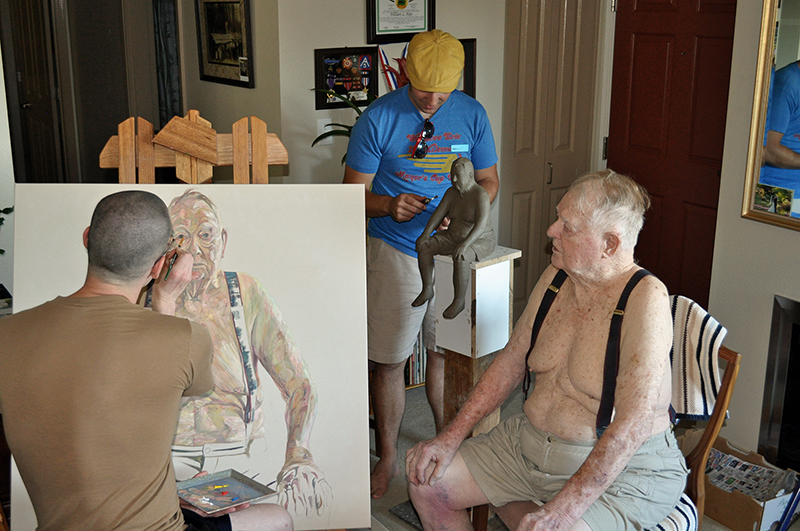

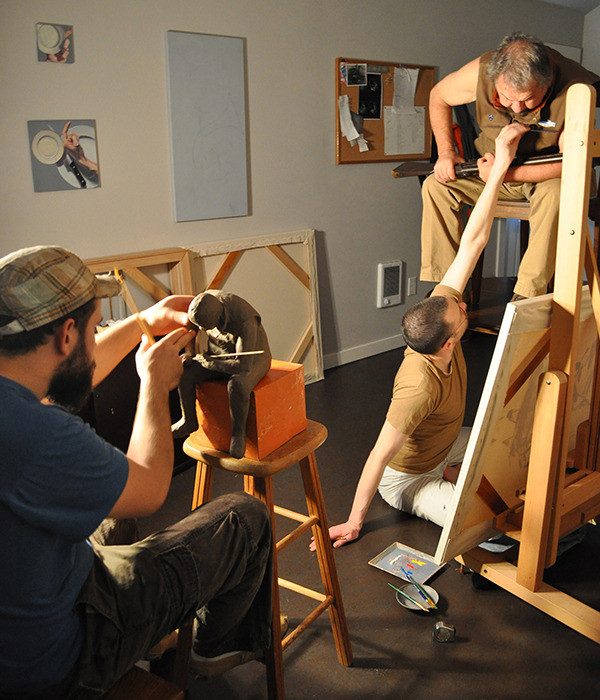
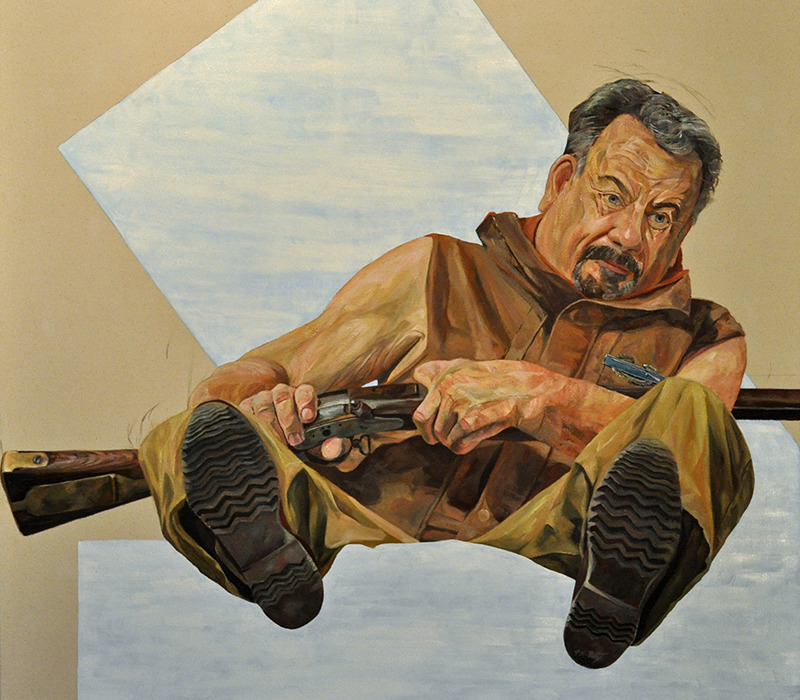
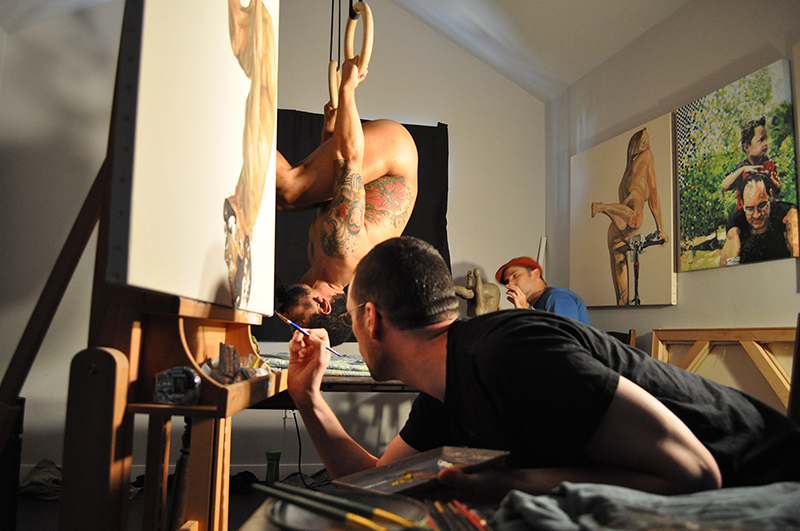
I started putting marks on canvas right away from the about the angle the photographer would have viewed him between helicopters. That’s rare for me. Usually I take time to sleep on an idea and come back early the next morning with coffee and a fresh view of my notes. I paid for my haste. After two sessions, I scraped down the painting and started over, deciding the image had no sense of the dynamism in a helicopter ride. After some brooding, I found the answer to the problem by shifting my own mode of looking. We set Lance on a chair perched on a table so I could paint him from below. Chris’s half of the portrait—the sculpture—would take care of situating Lance as a stable, sitting body, and between the two we thought we’d convey both Lance’s quiet strength and the wild ride he went on as a young man in Vietnam.
We found a rhythm over the next few weeks. While we worked we chatted through a free-association mix of tamale recipes, politics, Oregon outdoor adventures, Mars landers, and details about our early adulthood. For Chris, these memories are colored by his early plans to be a preacher. For Lance and me, those stories often have a military hue—mine the color of an aircraft carrier at sea, and his the color of long mountain marches.
Lance’s company spent much of the daylight combing the craggy mountains of central Vietnam for signs of a massive tunnel system rumored to house an underground combat hospital for the North Vietnamese Army. At night the NVA and Viet Cong came out of the tunnels, which brought about a stealthy cat-and-mouse game of ambushes and counter-attacks. Much of the American company would spend the night roving around setting up ambushes in the brush. But with his good nighttime reputation, Lance didn’t have to do a lot of that. Instead he was able to enjoy setting aside his bulky M-60 machine gun to take his turn with a smaller rifle and a starlight scope, looking at the rustling nighttime through it: two hours on, two off, until dawn.
I’ve never seen the shadowy world through a 1960s-era startlight scope, but I saw through similar military equipment in my Naval aviation role a decade ago and I’ve read about those scopes as an English major. As Lance spoke about lying in wait on a hill, panning back and forth while looking through the stack of round lenses, I remembered Yusef Komunyakaa’s poem “Starlight Scope Myopia.”
A well-regarded poet of the civil rights era, Komunyakaa received a Bronze Star for his service in Vietnam the same year that Lance earned his (1969). It took Komunyakaa nearly two decades to write about the war, finally publishing a book on the subject in 1988 titled Dien Cai Dau, which is Vietnamese for “crazy.”
I put on my scholar’s hat to tell Lance about the poem, “Starlight Scope Myopia,” extolling what I take to be its effective meditation on the scope’s tendency to pull the shooter-viewer into this round, monochromatic world. The result is a unique kind of near-sightedness. Komunyakaa opens the poem with the sight of distant people-shadows lifting other shadows onto an oxcart, a scene he says will live in the riflemen’s heads for years. He closes the poem this way, refining—I said with scholarly authority—the distance between shooter and target:
One of them is laughing.
You want to place a finger
to his lips & say “shhhh.”
You try reading ghost-talk
on their lips. They say
“up-up we go,” lifting as one.
This one, old, bowlegged,
you feel you could reach out
& take him into your arms. You
peer down the sights of your M-16
seeing the full moon
loaded on an oxcart.
The poem ends like that, with this hovering image of the moon on an ox cart. Readers pause on the shadowy, quiet, mystical scene available through spotting scopes, and explore how the sight of moving mouths can mingle with the scope viewer’s imagination—how other surrounding night sounds create the illusion that we can hear the far-off people speaking. And Komunyakaa’s use of second person (“you”) adds an important, menacing layer. Writing in second person allows readers to imagine themselves in the role of shooter, rather than the narrator. The power inherent in a rifle with night scope becomes yours. You think you know the men represented in this monochrome, shadowy text. You feel you can embrace them, and you can kill them.
I gave Lance a copy of the poem in an anthology, hoping for more opportunities to talk about the optical strangeness in those situations. I’m a painter. I think about these things all the time. What I don’t think much about—and here’s an example of my own myopic view of combat scopes and luminance—is the memories someone like Lance must have entwined with those of the full moon apparently loaded onto an ox cart. They aren’t pleasant, and they go deep.
Lance earned his reputation for keen starlight scoping this way: One night, on watch with his platoon sergeant, Lance whispered that he saw a figure appear in the scope, and then he started counting… 2, 3, 4, 5. “When I got to 8,” he told me, “I said, Holy shit there’s a company of NVA down there. I saw a mortar tube. It was very scary.” He said that there were 200 troops in total on their way to take out a different American company that the North Vietnamese had targeted.
Lance and his sergeant immediately sent word to their company to wake everyone up. Within a minute, he said, they lit up those ghostly shapes with everything they had. Lance set aside the M-16 with the starlight scope and picked up his usual M-60 machine gun, blasting at the shadows. The barrel got so hot he worried that it might melt.
In the morning, they found no bodies nor weapons among the helmets and other equipment left behind. Even in a hasty retreat, the North Vietnamese rarely left much for their enemy to use against them. “There were a lot of blood trails,” he said. But later, following those blood trails, the company found several shallow graves. The NVA often would put maps or other sensitive intelligence material under a rotting body to keep anyone from discovering it, assuming that pure revulsion would keep people away from valuable intel. “But we had orders,” Lance said. They dug up and turned over those bodies—careful to avoid any booby traps—and searched the whole scene thoroughly.
One grave appeared unusual. The man’s body was buried with some formality, in a wooden box instead of a simple hole in the ground. The Americans suspected the man must have been some kind of high ranking official. Opening the box revealed something big, yet not quite what they expected. It was obvious the man had still been alive when he was buried. The tips of the man’s fingers had rubbed away from scratching at the coffin’s insides, and his face was still twisted in what looked like a ghastly scream.
Conversations like this one give me a glimpse into the narrow scope I look through almost all the time. I hope talking about it 45 years later helps Mr. Grebner, too.I know that Vietnam still lives in his rifleman’s mind. He loves restoring muzzle loaders, but he still can’t touch a black rifle—nothing that looks or feels like an M-16, M-14, or AR-15. They bring back the hands-on sensation of killing people, he said.
We were nearly finished with the portrait when I told Lance how much I’d like to see the photo we were approximating, the one of him in the helicopter with the M-60 and the cigar. “Oh…I don’t have it,” he said, then described the many dead ends he has met while trying to track down the photographer, a print, or a negative. “I’ve never seen it. I only know it was taken.” That seems to fit. In clay and paint, two young adults have helped a retiree construct an echo of a photo that may not exist, using a weapon from a much older war as a stand-in. Looking at our portrait, I feel some hint of the long history of organized violence, the recovery across generations, and the slipping away of lessons learned.
— Paul X. Rutz
Between Here and There opens Friday, Nov. 7 from 7 to 10 p.m. at Scott Foster’s Good: a gallery in North Portland.
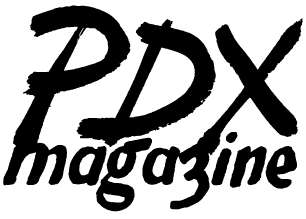
Forever Wars: The Literature of the Contemporary Wars | The Literature of the Contemporary Wars
[…] their distance from the painter. To read more about the painter and the project, check out: https://pdxmag.com/archives/3576 Posted on March 27, 2015March 29, 2015Author Aaron […]
Dear Artists, Toss the Instructions and Forget the Critics - PDX MagazinePDX Magazine
[…] projects that depend on compromise with another practitioner. I wrote about one of those efforts, a partnership with sculptor Christopher Wagner, in this magazine last […]